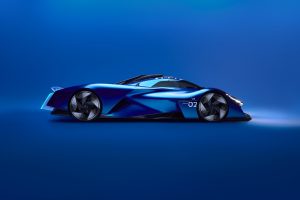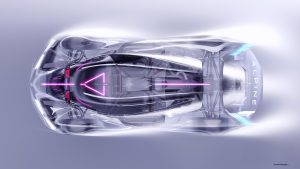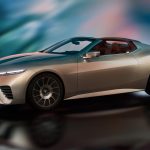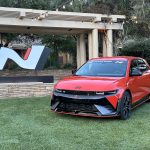Originally introduced in pure concept form at the 2022 Paris Motor Show, French automaker Alpine apparently has some serious plans for the Alpenglow hypercar. A running version, dubbed the Alpine Alpenglow Hy4 is set to take to the track for the 6-hour Spa-Francochamps endurance race this weekend. What stands out is not just the exotic design and impressive performance but the fact that the Hy4 uses a hydrogen-powered internal combustion engine.

As the name implies, the Alpine Alpenglow Hy4 currently uses a 4-cylinder internal combustion engine.
We’ve been hearing a lot about hydrogen in recent months as automakers continue to roll out both fuel-cell-powered passenger cars and trucks. Now, French automaker Alpine wants to take things to extreme with a prototype it is billing as “the mother of all future Alpines.”
Two years ago, the automaker revealed the Alpine Alpenglow at the Paris Motor Show. At the time it was largely dismissed as an extreme show vehicle. But the company, best known for exotic sports cars and racers, has proved doubters wrong. It has turned the concept into a “rolling lab,” with what appears to be serious intention of taking the next step into production if the underlying technology proves viable.
Hydrogen power
That’s a big question, however.
Certainly there are a number of production vehicles now running on hydrogen, such as the Toyota Mirai and Hyundai Nexo, as well as heavy-duty trucks from start-up Nikola. But those draw power from fuel-cell stacks. At their most basic, they combine hydrogen and oxygen from the air in the presence of a catalyst like platinum. In turn, that produces both water vapor and a flow of current that can power a vehicle’s electric motors. That’s why a fuel-cell stack is often referred to as a “refillable battery.”
In Alpine’s case, though, the Alpenglow is powered by an internal combustion engine, here modified to use hydrogen instead of gasoline. In its current configuration that’s an inline-four, as the Hy4 names suggests. It makes a relatively modest 340 hp. But that’s just for now.
The company said in a statement it’s developing “an all-new V6 engine specifically designed to be powered by hydrogen, developed entirely by Alpine.” It’s expected to unveiled, the release adds, “before the end of the year” in a second rolling version of the Hy4.
“Decarbonising motorsports”
New regulations are calling for a rapid shift away from internal combustion technology, or ICE, in the retail automotive market. The Biden administration wants to about two-thirds of all new vehicles sold in the U.S. by 2032 to run on battery power. The European Union, Canada and the United Kingdom want to phase out ICE technology by 2035.
There’s a growing interest in following a similar path in the racing world. Formula 1, NASCAR and other series are introducing various forms of hybrid technology and Formula E has pioneered all-electric racing.

Alpine sees the Alpenglow Hy4 as the “mother” of its future products — and as a prototype for decarbonizing motor sports.
“As part of our active participation in decarbonising motorsports, we see the hydrogen internal combustion engine as an extremely promising solution,” said Alpine Motorsports Vice President Bruno Famin. “We know that hydrogen will be an essential step in decarbonising the next generations of Endurance cars, and could also be for Formula 1 cars, particularly by switching to liquid storage for greater compactness and performance.
“The Alpenglow prototype perfectly illustrates this, a genuine technological laboratory for developing tomorrow’s hydrogen engines,” Famin said.
More Hydrogen News
- Honda Launches New CR-V e:FCEV Fuel-Cell Vehicle
- Shell Shuts Down Retail Hydrogen Stations in California
- Review: BMW iX5 Hydrogen
On the track
A subsidiary of the French auto giant Renault which is already looking at a variety of ways to use hydrogen power. It’s now marketing light commercial vehicles using more familiar fuel-cell technology.
Where Alpine and its parent might go next with the technology in the Alpenglow Hy4 is uncertain, however. There is some support for using it in the motorsports world, if for no other reason than the ability to refuel much more rapidly than a battery can be recharged. Toyota is also tinkering with hydrogen ICE, launching the technology onto the track in June 2023 in a modified Corolla.
“This is a world first for a liquid hydrogen car to race,” said Toyota Chairman Akio Toyoda. “We hope it will offer another option in the fight against global
warming.”
Drawbacks
But there are plenty of skeptics who caution that burning hydrogen in an internal combustion offers far fewer advantages than using the lightweight gas in a fuel-cell stack. For one thing, it actually isn’t entirely free of emissions, the high heat generated in the cylinders creating low-level oxides of nitrogen.
More significantly, hydrogen is far less efficient as a power source when burned, rather than used in a fuel-cell system. And that’s a potentially deal-breaking drawback considering that there are no natural sources of the gas. It must be produced either through electrolysis or by cracking hydrocarbons, such as as petroleum, natural gas or even coal. As a result, that greatly diminishes the emissions benefits, even as costs rise to well above what a motorist today pays per driven miles using gasoline or electricity.
A number of other automakers have tinkered with hydrogen ICE, including BMW and Mazda. Without a solution to the various problems associated with the technology it may never find use in passenger vehicles – perhaps with the exception of rare exotic hypercars. But it may yet find real-world benefits in motor sports.










0 Comments